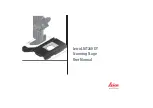
CONTENTS
GLOSSARY
INDEX
69
69
Chapter 5
Scanning Techniques
5. Click the Eyedropper tool on the point of the image you want to sample.
That value is entered in the corresponding text box, and the image adjusts
according to that value.
6. If the area of the image surrounding the sampled area changes tone as
you expected, make a note of the settings. If the selected image area does
not change tone as you expected, repeat this process until you get the
results you want.
Enhancing Color Images
This is a brief discussion about color basics. There are many good books about
working with graphic images. If you are using color imaging software such as
Adobe Photoshop LE, your software documentation can provide you with
more information to help you adjust your images when they have been
scanned and acquired by the imaging software.
About Image Color and Color Channels
All printable colors can be created using a combination of the colors cyan,
magenta, and yellow (CMY). (Black is often used in printing, so you may hear
that colors are printed using the “colors” CMYK, the K stands for “Key
color.”)
All colors displayed on monitors can be created using a combination of the
colors red, green, and blue (RGB). Red, green, and blue can be thought of as
complementary colors to cyan, magenta, and yellow-that is, the colors cancel
each other out when combined in equal amounts. Similarly, adding a small
amount of one color reduces its complement by that amount.
This complementary relationship between the colors cyan, magenta, and
yellow and the colors red, green, and blue can be represented using a color
wheel that indicates the possible colors and their opposites.
Green
Yellow
Blue
Cyan
Red
Magenta
















































